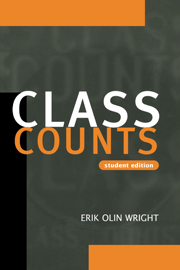Book contents
- Frontmatter
- Contents
- Preface to student edition
- Preface to original edition
- Acknowledgments
- 1 Class analysis
- Part I Structural analyses of classes
- Part II Class and gender
- Part III Class structure and class consciousness
- 10 A general framework for studying class consciousness and class formation
- 11 Class structure, class consciousness and class formation in Sweden, the United States and Japan
- Part IV Conclusion
- References
- Index
- Index of subjects
11 - Class structure, class consciousness and class formation in Sweden, the United States and Japan
Published online by Cambridge University Press: 22 September 2009
- Frontmatter
- Contents
- Preface to student edition
- Preface to original edition
- Acknowledgments
- 1 Class analysis
- Part I Structural analyses of classes
- Part II Class and gender
- Part III Class structure and class consciousness
- 10 A general framework for studying class consciousness and class formation
- 11 Class structure, class consciousness and class formation in Sweden, the United States and Japan
- Part IV Conclusion
- References
- Index
- Index of subjects
Summary
This chapter will try to apply some of the elements of the models elaborated in the previous chapter to the empirical study of class formation and class consciousness in three developed capitalist countries – the United States, Sweden and Japan. More specifically, the investigation has three main objectives: first, to examine the extent to which the overall relationship between class locations and class consciousness is broadly consistent with the logic of the class structure analysis we have been using throughout this book; second to compare the patterns of class formation in the three countries; and third to examine the ways in which the micro, multivariate models of consciousness formation vary across the three countries. The first of these tasks centers on exploring the “class location –limits→ class consciousness” segment of the model, the second focuses on the “class structure –limits→ class formation” segment, and the third centers on the “macro –mediates→ micro” aspect of the model.
In the next section we will discuss the strategy we will deploy for measuring class consciousness. This will be followed in section 11.2 with a more detailed discussion of the empirical agenda and the strategies of data analysis. Sections 11.3 to 11.5 will then present the results of the data analysis.
11.1 Measuring class consciousness
Class consciousness is notoriously hard to measure. The concept is meant to denote subjective properties which impinge on conscious choosing activity which has a class content.
- Type
- Chapter
- Information
- Class Counts , pp. 216 - 248Publisher: Cambridge University PressPrint publication year: 2000



